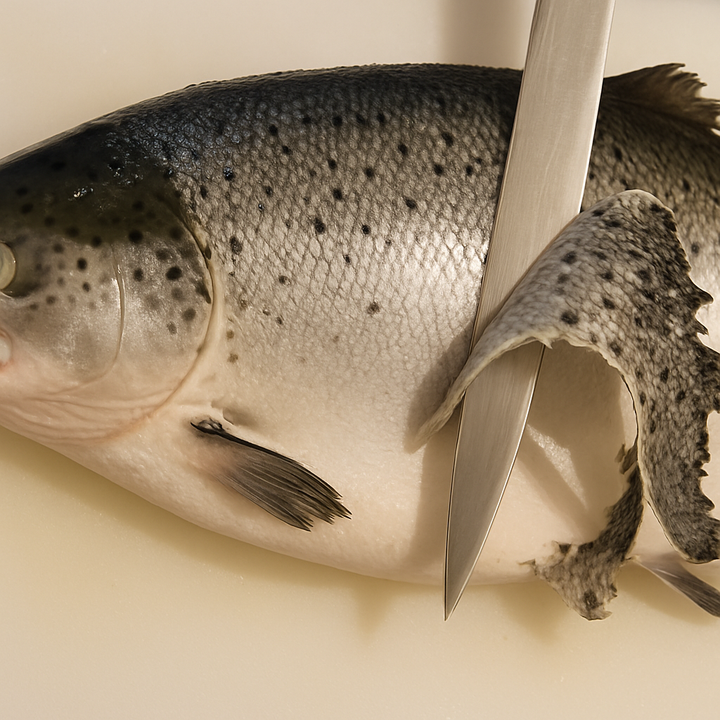Tomahawk Steak in French Cuisine: Tradition Meets Innovation
France's beloved Côte de Boeuf—a premium bone-in ribeye—embodies culinary heritage while evolving through Polmard's revolutionary aging techniques, balancing tradition with innovation in modern gastronomy.

Imagine sitting in a cozy French bistro, the air thick with the tantalizing aroma of grilled meat.
The waiter approaches, presenting a platter crowned with a magnificent Côte de Boeuf—its bone jutting out like a rustic handle, the meat seared to a golden brown.
You slice into it, and the juices spill forth, each bite a symphony of rich, savory bliss. This is French culinary tradition at its finest, where humble ingredients become extraordinary.
Côte de Boeuf, a thick, bone-in rib steak, has long been a jewel in France’s gastronomic crown, prized for its flavor and tenderness.
Yet, today, it’s being reimagined by innovators like Alexandre Polmard, a sixth-generation butcher whose groundbreaking techniques are blending heritage with modernity.
In this article, we’ll explore Côte de Boeuf’s storied role in French cuisine, its classic preparation, Polmard’s revolutionary twist, and why this evolution matters to food lovers everywhere.
A Staple of French Culinary Heritage
Côte de Boeuf is more than just a steak—it’s a celebration of French culinary values.
Known in American butchery as a tomahawk or bone-in ribeye steak. Cut from the rib primal of the cow, this hefty slab boasts generous marbling and a bone that infuses it with deep, beefy flavor during cooking.
For centuries, it’s been a fixture in upscale French dining, often served as a grand centerpiece for sharing.
Picture a lively table in Provence or Paris, friends and family gathered around a sizzling Côte de Boeuf, passing plates and pouring wine.
This communal aspect underscores its cultural weight, embodying the French love for conviviality and quality.
Traditionally, preparation is straightforward, honoring the meat’s natural excellence.
Chefs season it sparingly—salt, pepper, perhaps a whisper of thyme or rosemary—before grilling or roasting it over an open flame or in a scorching oven.
The goal? A caramelized crust encasing a juicy, rosy interior. In Bordeaux, Côte de Boeuf à la Bordelaise reigns supreme, pairing the steak with a luscious sauce of red wine, shallots, and bone marrow.
This regional classic elevates the dish without overshadowing its essence, proving that simplicity and sophistication can coexist.
Whether savored in a rustic countryside auberge or a Michelin-starred restaurant, Côte de Boeuf reflects France’s reverence for craftsmanship and terroir.
Polmard’s Revolutionary Approach
Now, enter Alexandre Polmard, a visionary who’s rewriting the Côte de Boeuf playbook.
Hailing from a family of butchers stretching back six generations, Polmard has introduced a game-changing aging process called “hibernation.”
Unlike traditional dry or wet aging, this method stores the meat at a frigid -43°C (-45°F) in a custom chamber, where high-speed air circulates at 120 km/h (75 mph).
Inspired by aerospace technology, this isn’t freezing—it’s a controlled maturation that preserves the meat’s cellular integrity.
The result? Steaks aged for years, sometimes decades, without losing freshness.
Polmard’s hibernation aging process allows enzymes to slowly tenderize the meat, unlocking flavors that are rich, buttery, and subtly sweet—qualities unattainable through conventional methods.
A bite of his Côte de Boeuf is a revelation: meltingly tender yet robust, familiar yet futuristic.
Sourced from his family’s Blonde d’Aquitaine cattle, raised with meticulous care in Lorraine, the meat’s quality is unmatched.
This innovation doesn’t come cheap—some cuts fetch upwards of $3,200—but for gastronomes, it’s a once-in-a-lifetime experience.
Polmard’s work is a bold redefinition of a classic, proving that tradition can be a springboard for progress.
Perspectives from French Chefs
French culinary luminaries have taken note, praising Polmard’s Côte de Boeuf for its artistry.
Chef Alain Ducasse, a giant in the gastronomic world, calls it “a masterpiece. The aging process brings out flavors that are simply extraordinary.
It’s a testament to how innovation can enhance our heritage.” His words capture the dish’s dual nature—rooted in the past, reaching for the future.
Likewise, Chef Hélène Darroze, celebrated for her Michelin-starred kitchens, reflects: “While I cherish the traditional methods, Polmard’s approach shows there’s always room for improvement. His steak is a revelation.”
These insights reveal a broader truth: French cuisine thrives on evolution.
Chefs respect the time-honored techniques—grilling over wood fires, basting with butter—but they also embrace advancements that elevate the craft.
Polmard’s Côte de Boeuf strikes this balance, earning accolades for its flavor and texture while sparking conversations about the future of butchery.
It’s a dish that invites both nostalgia and wonder, uniting generations of culinary wisdom.
Why It Matters: France’s Gastronomic Legacy
So why does Côte de Boeuf—and Polmard’s reinvention—matter? It’s a microcosm of France’s gastronomic legacy, where food is more than sustenance; it’s culture, history, and identity.
Beef has long held a special place in French dining, from the hearty stews of the peasantry to the refined cuts of haute cuisine. Côte de Boeuf, with its imposing presence and bold flavor, epitomizes this heritage.
It’s a dish that demands respect—for the animal, the butcher, the chef, and the land it came from.
Polmard’s innovation doesn’t discard this legacy; it enriches it. By pushing boundaries, he ensures that French cuisine remains dynamic, not a museum piece frozen in time.
His Côte de Boeuf bridges the rustic bistros of yesteryear with the cutting-edge kitchens of tomorrow, appealing to purists and pioneers alike.
For readers passionate about food culture, this evolution is a thrilling narrative: a story of tradition meeting ingenuity, of a steak that carries the weight of history while carving a path forward.


